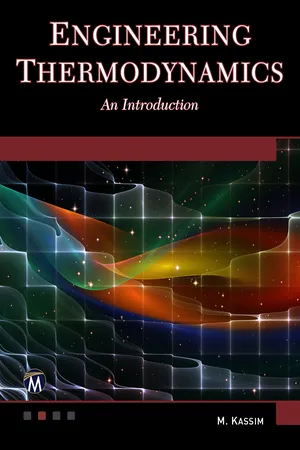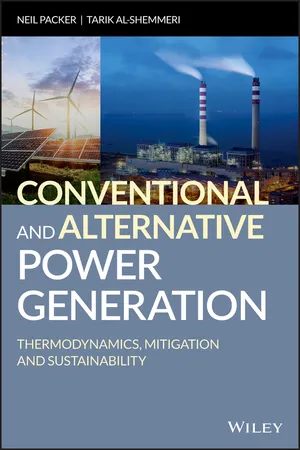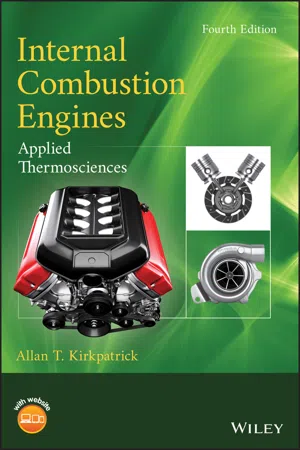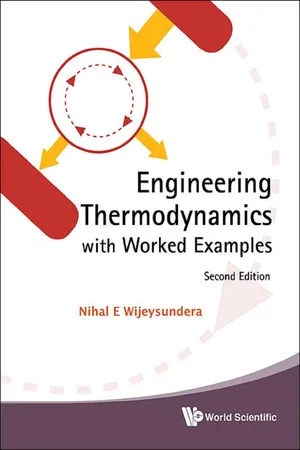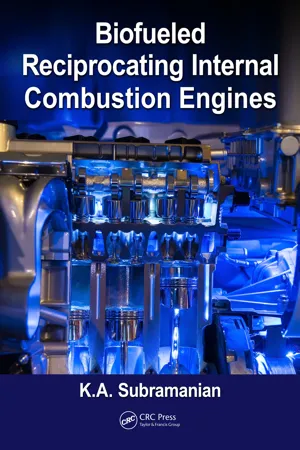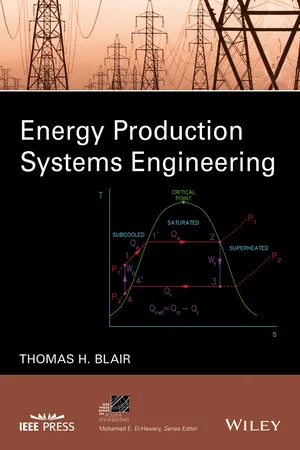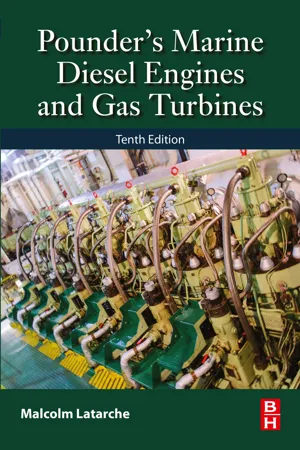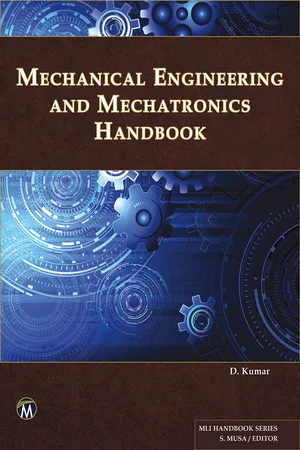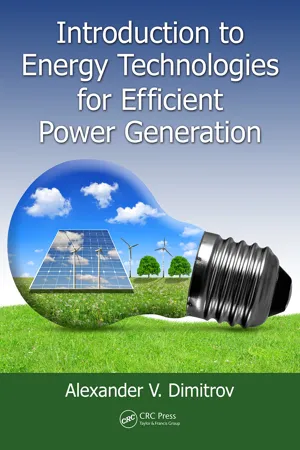Physics
Engine Cycles
Engine cycles refer to the sequence of events that occur within an internal combustion engine during operation. These events typically include intake, compression, power, and exhaust strokes. The engine cycle is crucial for converting fuel into mechanical energy, and it plays a fundamental role in the functioning of various types of engines, such as those found in automobiles and aircraft.
Written by Perlego with AI-assistance
Related key terms
11 Key excerpts on "Engine Cycles"
- eBook - ePub
Thermal Power Plant
Design and Operation
- Dipak Sarkar(Author)
- 2015(Publication Date)
- Elsevier(Publisher)
Rankine cycle .A thermodynamic cycle is ideally be made up of any three or more thermodynamic processes as follows:i. Isothermal (constant temperature) process ii. Isobaric (constant pressure) process iii. Isochoric (constant volume) process iv. Adiabatic (no heat is added or removed from the working fluid) process v. Isentropic or reversible adiabatic (no heat is added or removed from the working fluid and the entropy is constant) process vi. Isenthalpic (constant enthalpy) processTable 1.1 shows some examples of thermodynamic cycles.Table 1.1 Example of thermodynamic cyclesCycle/Process Compression Heat addition Expansion Heat rejection External combustion power cycles: Carnot isentropic isothermal isentropic isothermal Stirling isothermal isochoric isothermal isochoric Ericsson isothermal isobaric isothermal isobaric Internal combustion power cycles: Otto (Gasoline/Petrol) adiabatic isochoric adiabatic isochoric Diesel adiabatic isobaric adiabatic isochoric Brayton adiabatic isobaric adiabatic isobaric (Note: Details on internal combustion power cycles can be found in Chapters 7 and 8 .)In a simple steam power plant as the fluid circulates it passes through a continuous series of cyclic mechanical and thermodynamic states. Water enters a steam generator at a certain pressure and temperature and gets converted to steam, the high-pressure steam then enters a steam turbine and expands to a low pressure while passing through the turbine, the low pressure steam then gets condensed in a condenser, and the condensed water is recycled back to the boiler at original pressure and temperature (Figure 1.3 ) [6 ,7] - eBook - ePub
Engineering Thermodynamics
An Introduction
- M. Kassim(Author)
- 2022(Publication Date)
- Mercury Learning and Information(Publisher)
6 THERMODYNAMIC CYCLES6.1 INTRODUCTIONThe majority of power-producing machines work on thermodynamic cycles and therefore research and development work in the area of thermodynamics has assumed to gain very high importance.Every power engine operates as a steady-state device and does not store power. The working fluid passes through a series of processes forming a closed-loop cycle. The cycle of processes is repeated again and again as the engine operates.Thermodynamic cycles are classified as gas cycles and vapor cycles. In gas cycles, the fluid remains in gaseous phase, whereas the face may change in vapor cycles. If steam is the working fluid, it will be gas in some processes and liquid in other processes.Thermodynamic cycles are also classified as an open cycle and a closed cycle. In a closed cycle, the same working fluid is moved from initial to fluid state and then recirculates. In the case of open cycles, the working fluid is changed in each cycle and not being recirculated. In a car engine, the burnt gases can be exhausted and a fresh mixture of air and fuel is changed at the end of every cycle.There are engines where the working fluid does not undergo an entire thermodynamic cycle. Thermodynamic cycles are also categorized as per their utility.1. Power cycles2. Heat pump and refrigeration cycles.1. Power cycles: - eBook - ePub
Conventional and Alternative Power Generation
Thermodynamics, Mitigation and Sustainability
- Neil Packer, Tarik Al-Shemmeri(Authors)
- 2018(Publication Date)
- Wiley(Publisher)
There are two categories of engine in use in the power industry. They are classified according to the supply of heat to produce the mechanical power that, in turn, is converted into electrical energy. These are:- Internal combustion engines: These use either the standard Otto cycle or the Diesel cycle.
- External combustion engines: This type mainly relies on the Stirling engine.
3.5.1 Internal Combustion Engines
An internal combustion engine converts fuel into mechanical energy. The most common fuel is liquid, such as petrol (gasoline) or diesel. There are distinct differences in the design and operation of these two fuels and the engine design necessary to utilize them. There are also two thermodynamic cycles to describe the behaviour of these two engines.The applications of internal combustion engines include the provision of the mechanical power source for most transport whether by road, rail, sea or air, as well as for industrial equipment such as air compressors and pumps, and for the provision of electrical energy, as in the case of portable power generators.3.5.2 The Otto Cycle
This practical cycle applies to the petrol or spark‐ignition engine, which is perhaps the most common heat engine in popular use. The cycle was originally proposed in 1862 but was made practicable by the German scientist Nikolaus Otto in 1876.The Otto cycle is an ideal air standard cycle, which approximates the actual cycle. Figure 3.9 illustrates the Otto cycle on a P–v diagram.The cycle consists of four non‐flow processes. In state 1, the engine cylinder is assumed to be full of air at approximately atmospheric pressure and temperature. The piston is at the bottom dead centre (BDC) position.Figure 3.9 The Otto cycle P–v diagram.Process 1–2 is an isentropic (adiabatic and reversible) compression of the air. The piston moves to top dead centre (TDC), compressing the air into the clearance volume and so raising its pressure and temperature.Process 2–3 is heat addition at constant volume. The piston remains at TDC whilst the heat is supplied from the surroundings and the pressure and temperature are raised to their maximum values in the cycle. - eBook - ePub
Internal Combustion Engines
Applied Thermosciences
- Allan T. Kirkpatrick(Author)
- 2020(Publication Date)
- Wiley(Publisher)
Chapter 2 Ideal Gas Engine Cycles2.1 Introduction
Studying ideal gas Engine Cycles as simplified models of internal combustion engine processes is very useful for illustrating the important parameters influencing engine performance. Ideal gas engine cycle analysis treats the combustion process as an equivalent energy addition to an ideal gas. By modeling the combustion process as an energy addition, the analysis is simplified since the details of the physics and chemistry of combustion are not required. The various combustion processes are modeled either as constant volume, constant pressure, or finite energy release processes.The internal combustion engine is not a heat engine, since it relies on internal combustion processes to produce work, and it is an open system with the working fluid flowing through the cylinder. However, gas engine models are useful for introducing the cycle parameters that are also used in more complex combustion cycle models, specifically the fuel–air cycle, to be introduced in Chapter 4. The fuel–air cycle accounts for the change in composition of the fuel–air mixture during the combustion process.This chapter also provides a review of closed‐system and open‐system thermodynamics. This chapter first uses a first‐law closed‐system analysis to model the compression and expansion strokes and then incorporates open‐system control volume analysis of the intake and exhaust strokes. An important parameter in the open‐system analysis is the residual fraction of combustion gas, , remaining in the cylinder at the end of the exhaust stroke.Let us assume, to reduce the complexity of the mathematics, that the gas cycles analyzed in this chapter are modeled with an ideal gas that has a constant specific heat ratio and gas constant . This assumption results in simple analytical expressions for the efficiency as a function of the compression ratio. Chosen values of for internal combustion engine gas cycle calculations typically range between 1.2 and 1.4, and values of the gas constant typically vary between 0.28 and 0.31 kJ/kg‐K. An unburned stoichiometric iso‐octane/air mixture at a compression temperature of 650 K has = 1.31 and = 0.28 kJ/kg‐K, and after combustion at an expansion temperature of 2250 K the equilibrium combustion product mixture has = 1.19 and - eBook - ePub
- Nihal E Wijeysundera(Author)
- 2016(Publication Date)
- WSPC(Publisher)
Chapter 10
Gas Power Cycles
In the last chapter we analyzed vapor power cycles with working fluids that undergo phase change during operation. However, many common prime movers like petrol engines, diesel engines, and gas turbines use gases as working fluids and their operating cycles are known as gas power cycles. In this chapter we shall analyze gas power cycles considering their performance mainly under ideal conditions.10.1 Internal-Combustion Engine Cycles
Reciprocating gasoline engines and diesel engines, widely used in motor cars, trucks, buses and other transport applications, are commonly called internal combustion engines. There are two broad categories of such engines which use different mechanisms of combustion. These are known as spark-ignition engines and compression-ignition engines.10.1.1 Spark-ignition (SI) engines
In this section we shall consider briefly the basic mode of operation of a typical spark-ignition (SI) engine. Figure 10.1 depicts a schematic of the piston cylinder arrangement that forms the core of the engine. The reciprocating motion of the piston is converted to a rotation of the shaft with the aid of a connecting rod, that links the piston to a crank attached to the shaft. The basic form of the engine consists of an inlet valve through which a mixture of fuel and air is admitted into the cylinder, and an exhaust valve through which the products of combustion are discharged to the atmosphere.Fig. 10.1 Reciprocating internal combustion engineFig. 10.2 SI engine: (a) Ideal P-v diagram, (b) Actual P-v diagramThe ideal and actual pressure–volume (P-v ) diagrams for the gases in the cylinder during operation are shown in Figs. 10.2(a) and 10.2(b) respectively. At point 1 in the P-v diagrams the exhaust valve closes and the inlet valve opens to admit a fresh mixture of fuel and air. At this stage the piston is at the top-dead-centre (tdc) where it is closest to the cylinder head. As the piston moves out the pressure in the cylinder is ideally equal to the atmospheric pressure as seen in Fig. 10.2(a) , whereas the actual pressure is slightly below as indicated in Fig. 10.2(b) - K.A. Subramanian(Author)
- 2017(Publication Date)
- CRC Press(Publisher)
4 Introduction to Internal Combustion Engines4.1 IntroductionEnergy exists in several forms such as chemical, thermal, potential, kinetic, light, nuclear, magnetic, and electrical energy. Petroleum fuels such as gasoline, diesel, kerosene, propane, and butane have chemical energy that can be converted into heat and then work using heat engines. A heat engine is a device for producing motive power from heat.An internal combustion engine, which is a heat engine, produces mechanical power by converting chemical energy into heat energy and then mechanical power. “Internal combustion” means combustion of fuels in a closed system (closed boundary system). In an internal combustion engine, heat is released by exothermic reaction of reactants (air and fuel) in a closed system when both intake and exhaust valves are closed. Heat energy is released by burning the air-fuel charge in the combustion chamber and then the heat energy is converted to mechanical power by movement of piston motion (movement of system boundary).Heat and work are both transient phenomena and systems cannot possess heat or work. When a system undergoes a change, heat or work transfer may occur. Both heat and work cross the boundary of the system. Heat is defined as the form of energy that is transferred across the boundary by virtue of difference of temperature or temperature gradient. Work done is due to change in boundary of the system. The work done by the system and on the system are represented by + and – and heat flowing into the system and flowing out of the system are referenced as + and –.Thermodynamics is a branch of physical science that deals with the relations between heat and other forms of energy. Thermodynamics deals with the conversion of chemical energy to heat and then work. Heat is defined as energy in transit. Work done is defined as the product of the force (combustion pressure X area) and the distance (piston movement) due to expansion of working fluid (boundary) by combustion. A thermodynamic system can be described using thermodynamics coordinates. The main thermodynamics coordinates are pressure (P ), volume (V ), temperature (T ), and entropy (S ) that are used for assessment of performance of a heat engine. The heat available in the system can be described using the coordinates of temperature and entropy whereas work done by the system is dealt by pressure and volume. P -V and T -S- eBook - ePub
- Thomas Howard Blair(Author)
- 2016(Publication Date)
- Wiley-IEEE Press(Publisher)
x. Please see the emissions section of this text for more information on emissions control.GLOSSARY OF TERMS
- Camshaft – Shaft that is moved by the crankshaft with two or more offset cams (lobes) that operate the valves.
- Combustion – Process in which a substance reacts with oxygen to give heat and light (burning).
- Compression – The action of compressing or being compressed. The reduction in volume (causing an increase in pressure) of the fuel mixture in an internal combustion engine before ignition.
- Compression Ratio – Ratio of the volume of the cylinder at the bottom of the cylinder travel normalized to the volume of the cylinder at the top of the cylinder travel.
- Crank/crankshaft – Rod that spins and drives a piston movement in the cylinder.
- Combustion – rapid chemical combination of a substance with oxygen, involving the production of heat and light.
- Cylinder – Central working part of a reciprocating (or piston) engine, the space through which a piston travels.
- Diesel Cycle – The Diesel cycle is a combustion process of a reciprocating internal combustion engine. In it, fuel is ignited by heat generated during the compression of air in the combustion chamber, into which fuel is then injected.
- Exhaust – Gases ejected from an engine as waste products.
- Expansion – The action of becoming larger or more extensive.
- Four-Stroke Engine – A four-stroke engine (also known as four-cycle) is an internal combustion engine in which the piston completes four separate strokes which constitute a single thermodynamic cycle. A stroke refers to the full travel of the piston along the cylinder, in either direction.
- eBook - ePub
- Malcolm Latarche(Author)
- 2020(Publication Date)
- Butterworth-Heinemann(Publisher)
The ideal efficiency of this cycle (i.e. the hypothetical indicator diagram) is about 55%–60%: that is to say, about 40%–45% of the heat supplied is lost to the exhaust. Since the compression and expansion strokes are assumed to be adiabatic, and friction is disregarded, there is no loss to coolant or ambient. For a four-stroke engine, the exhaust and suction strokes are shown by the horizontal line at C, and this has no effect on the cycle.Practical cycles
While the theoretical cycle facilitates simple calculation, it does not exactly represent the true state of affairs. This is because:- 1. The manner in which, and the rate at which, heat is added to the compressed air (the heat release rate) is a complex function of the hydraulics of the fuel injection equipment and the characteristic of its operating mechanism; of the way the spray is atomized and distributed in the combustion space; of the air movement at and after top dead centre (ATDC) and to a degree also of the qualities of the fuel.
- 2. The compression and expansion strokes are not truly adiabatic. Heat is lost to the cylinder walls to an extent, which is influenced by the coolant temperature and by the design of the heat paths to the coolant.
- 3. The exhaust and suction strokes on a four-stroke engine (and the appropriate phases of a two-stroke cycle) do create pressure differences which the crankshaft feels as ‘pumping work’.
It is the designer’s objective to minimize all of these losses without prejudicing the first cost or reliability, and also to minimize the cycle loss: that is, the heat rejected to exhaust. It is beyond the scope of this book to derive the formulae used in the theoretical cycle, and in practice, designers have at their disposal sophisticated computer techniques, which are capable of representing the actual events in the cylinder with a high degree of accuracy. But broadly speaking, the cycle efficiency is a function of the compression ratio (or more correctly the effective expansion ratio of the gas–air mixture after combustion).The theoretical cycle (Fig. 2.1 ) may be compared with a typical actual diesel indicator diagram such as that shown in Fig. 2.2 . Note that in higher speed engines, combustion events are often represented on a crank angle, rather than a stroke basis, in order to achieve better accuracy in portraying events at the top dead centre (TDC) as shown in Fig. 2.3 - eBook - ePub
- D. Kumar, Sarhan M. Susa(Authors)
- 2022(Publication Date)
- Mercury Learning and Information(Publisher)
3INTERNAL COMBUSTION ENGINES3.1. HEAT ENGINESA machine or device which derives heat from the combustion of fuel and converts part of this energy into mechanical work is called a heat engine. Heat engines are broadly classified into internal combustion engines and external combustion engines.An internal combustion engine is a reciprocating heat engine in which fuel mixed with the correct amount of air is burned inside a cylinder. The gaseous products of combustion form the working substance which makes the piston move and produces mechanical work at the engine crankshaft. In contrast, the combustion of fuel in steam engines is external. Combustion takes place on the fire grate of the boiler, and the heat energy of fuel, thus, released is used to convert water into steam. The steam is then led to the steam engine or steam turbine where work is produced. Obviously, the working substance (steam) is generated in a boiler that is outside the power-producing device.Compared to steam engines, the IC engines are noted for— high overall efficiency: the efficiency of IC engines ranges from 30 to 35% whereas the efficiency of steam engines lies between 15 and 20%,— compact and small size,— low weight to power ratio,— easy and quick starting: in steam engines, firing of the boiler and generation of steam takes sufficient time, and— less maintenance and operating costs.The important applications of IC engines are as follows: ● - Alexander V. Dimitrov(Author)
- 2017(Publication Date)
- CRC Press(Publisher)
2Conversion of Thermal Energy into Mechanical Work (Thermal Engines)Energy-related (power) technologies may be treated as a combination of engineering-technical methods of energy and work conversion employed to facilitate human life. They are divided into two main groups. The first group comprises technologies of heat conversion into another type of energy (mechanical, electrical, electromagnetic, etc.) while the second one comprises technologies of heat transfer, accumulation, and regeneration. Each thermal technology discussed herein will be illustrated by specific physical schemes and devices. We shall consider them in the following order:•Technologies of mechanical work performance (so called thermomechanical technologies) •Technologies of generation of electrical energy (thermoelectric technologies) •Technologies of heat transformation (regeneration and recuperation) •Technologies of heat transfer and collection (transfer and accumulation) •Technologies creating comfortable environment (air conditioning and ventilation)Thus, we will treat a certain technology as an object of study of respective scientific-applied research fields, on one hand, and we will follow the teaching programs on “Power engineering,” “Transport management” and “General mechanical engineering,” on the other hand.2.1 Evolution of Engine TechnologiesAs is known from physics, energy conversion follows a natural course, that is, energy of motion of macro- and microbodies (popular as mechanical energy) is converted into heat by mechanisms that are studied by tribology (including dry, semi-dry, viscous, or turbulent friction). No opposite transformation is observed in nature. Heat conversion into energy needed for the operation of machines and mechanisms was an impossible task for primitive people as well as for those living in slave-holding* and feudal†- eBook - ePub
The Pilot's Manual: Multi-Engine Flying
All the aeronautical knowledge required to earn a multi-engine rating on your pilot certificate
- Mark Dusenbury, Shayne Daku, Robert Laux(Authors)
- 2015(Publication Date)
- Aviation Supplies & Academics, Inc.(Publisher)
called the Otto Cycle which can be broken down into four basic steps: intake, compression, combustion, exhaust. Each step—or stroke—is measured by the movement of the piston from the top position of the cylinder to the bottom. These two positions are referred to as top dead center (TDC) and bottom dead center (BDC) (Figure 2-1). Figure 2-1. The four piston movements of a four-stroke internal combustion engine. The four strokes of the cycle: Intake stroke : The piston begins at TDC and moves down the cylinder, drawing a mixture of air and fuel into the cylinder through an opening in the top of the cylinder called the intake valve; in the case of a fuel-injected engine, only air is drawn in on the intake stroke and fuel is added once the air has reached the cylinder. Once the piston reaches BDC, the intake valve closes and the intake stroke is complete. Compression stroke : With the intake and exhaust valves closed, the piston now travels back up the cylinder, compressing the mixture of air and fuel. The compression stroke ends when the piston reaches TDC. Power stroke : Just before the piston reaches TDC the air fuel mixture is ignited, causing a rapid thermal expansion of the mixture. This “rapid burn” creates a force that pushes the piston back down the cylinder towards BDC. This stroke ends when the piston reaches BDC. Exhaust stroke : as the piston reverses its direction and heads back up the cylinder, the exhaust valve opens allowing the spent air fuel mixture to be forced out of the cylinder. This stroke ends when the piston reaches TDC, and the cycle repeats, starting again with the intake stroke. The pistons are attached to a crankshaft that converts the linear action—up and down motion—into a rotational force. This rotational force is then used to spin the propeller, fuel pump, vacuum pump and alternator. This is referred to as the accessory drive
Learn about this page
Index pages curate the most relevant extracts from our library of academic textbooks. They’ve been created using an in-house natural language model (NLM), each adding context and meaning to key research topics.

